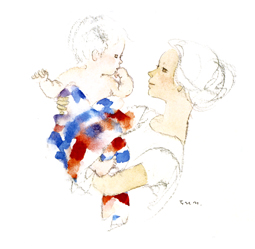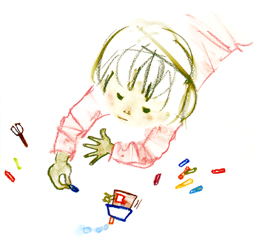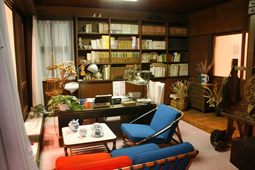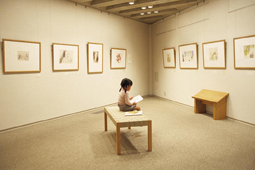 |
|
Here and There introduces art, artists, galleries and museums around Japan that non-Japanese readers and first-time visitors may find of particular interest. The writer claims no art expertise, just a subjective viewpoint acquired over many years' residence in Japan.
|
|
 |
|
|
 |
 |
Every Picture Tells a Story: The Chihiro Art Museum
Alan Gleason |
 |
 |
|
 |
| "Mother and Her Baby after a Bath," Chihiro Iwasaki, 1971. |
|
"Girl Drawing," Chihiro Iwasaki, 1970. |
In certain countries more than others, the children's picture book seems to have been embraced as a medium for serious artists. This is especially true in eastern Europe, where Russia, Poland and Czechoslovakia have spawned some of the world's finest picture-book art. Japan is another country where children's books contain art that appeals to kids of all ages, much of it downright wild and crazy, by such masters of the genre as Koji Suzuki, Taro Gomi, and Yosuke Inoue, to name but a few. Some of their imagery borders on the deranged. Indeed, one illustrator has quipped that he prefers working for a juvenile audience because it gives him more freedom to draw what he likes than when he is painting for adults.
One of Japan's most beloved children's book illustrators, however, represents what might be called the antithesis of the wild-things style favored by her peers. Chihiro Iwasaki (1918-1974) was a prizewinning, widely published illustrator throughout her thirty-year career, which lasted from the end of World War II right up until her untimely death at age 55. Chihiro not only created pictures for kids, they were also her favorite subject. She painted them with a sublimely gentle but confident touch that reflected her expertise in both Western watercolor and Japanese sumi-ink painting. Chihiro's work is ubiquitous in Japan, and my knee-jerk reaction to it had usually been "eh, too cute." But a visit to the Chihiro Art Museum in northwestern Tokyo proved a bit of an eye-opener in that regard.
True, Chihiro's style is not everyone's cup of tea. Her signature is the way she draws eyes: dark little pupil-less spots that on a bad day remind me of those velvet paintings of big-eyed children and puppies one sees on sale in tourist resorts. If you can get past that particular quirk, however, there is much to admire in Chihiro's painterly touch, and her work positively glows with love for her subjects -- it even shines through those strange little eyes.
Chihiro was prolific and acclaimed in her lifetime, so it was not long after her death that a foundation was established in her name and plans laid to build a museum to house her vast ouevre. The Chihiro Art Museum opened in 1977 on the site of the home and studio in Nerima-ku where she spent most of her career. So successful is the museum that it has been rebuilt and enlarged twice since then, most recently in 2002.
Meanwhile, in addition to housing Chihiro's work (9,500 pieces!), the museum has been steadily adding to what is now one of the world's largest assemblages of picture book art. Still growing, at last count the International Collection boasted over 17,000 works by 194 artists from 30 countries. To accommodate this burgeoning inventory the museum opened a second venue in 1997, the Chihiro Art Museum Azumino, in the foothills of the Japan Alps in Nagano Prefecture, about three hours by train west of Tokyo.
Though not nearly as large as its Azumino facility, the Tokyo branch of the museum offers something special to visitors: a glimpse of Chihiro's atelier, preserved as it was when she worked there. Most of the Tokyo gallery space is devoted to Chihiro's work, but one room is reserved for a rotating exhibition of works selected from the International Collection on various themes. This fall, until November 15, the theme is cats, a favorite picture-book motif if there ever was one. This often hilarious selection of feline images by artists from around the world is a delight whether you're a cat person or not.
Also on view into November are some of Chihiro's more sobering drawings of children victimized by war. Her 1973 series Senka no Naka no Kodomotachi (Children in the Flames of War) was inspired by the plight of children in Vietnam and Hiroshima. An artist with a strong social conscience, Chihiro nonetheless rarely revealed this side of herself in her picture-book illustrations. Seeing it on display here provides a somber, yet vital, balance to the sweetness and light of so much of the rest of her work.
 |
|
 |
| Chihiro's atelier, preserved at the Chihiro Art Museum Tokyo. |
|
One of the galleries featuring Chihiro's work at the Chihiro Art Museum Tokyo.
All images © Chihiro Art Museum |
|
|
|
|
|
 |
|
 |
|
 |
Chihiro Art Museum |
 |
|
|
Chihiro Art Museum Tokyo
4-7-2 Shimo-Shakujii, Nerima-ku, Tokyo
Phone: 03-3995-0612
Hours: Tuesday-Sunday, 10-5 (Golden Week and August 10-20: 10-6)
Closed Mondays and New Year's holidays
Transportation: 7 minute walk from Kamiigusa station on the Seibu Shinjuku Line
Chihiro Art Museum Azumino
Nishihara, Matsukawa-mura, Kita-Azumi-gun, Nagano Prefecture
Phone: 0261- 62- 0772
Hours: Thursday-Tuesday, 9-5 (Golden Week: 9-6); open every day of Golden Week and the month of August
Closed on 2nd and 4th Wednesdays and from December 1 through the last day of February
Transportation: 3 minutes by taxi or 25 minutes on foot from Shinano Matsukawa station on the JR Oito Line, north of Matsumoto City, Nagano Prefecture. By car, 20 minutes from Toyoshina IC on the Nagano Expressway. |
 |
|
|
 |
 |
Alan Gleason
Alan Gleason is a translator, editor and writer based in Tokyo, where he has lived for 25 years. In addition to writing about the Japanese art scene he has edited and translated works on Japanese theater (from kabuki to the avant-garde) and music (both traditional and contemporary). |
|
|
|
 |
 |
|